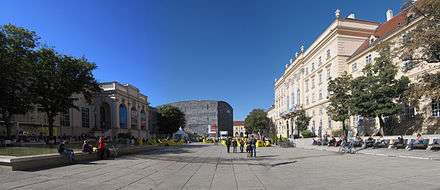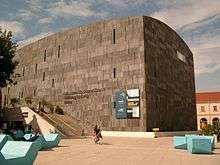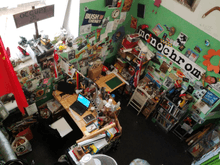Museumsquartier
The Museumsquartier (MQ) is a 90,000 m2 large area in the 7th district of the city of Vienna, Austria.
Highlights
The Museumsquartier contains Baroque buildings as well as Modern architecture by the architects Laurids and Manfred Ortner (Ortner & Ortner Baukunst). The renovation of the former court stables began in April 1998. Three years later, the Museumsquartier opened in two stages (June and September 2001). The total cost of the construction was 150 Million Euro (two billion Austria Schilling).
The MQ is home to a range of installations from large art museums like the Leopold Museum and the MUMOK (Museum of Modern Art Ludwig Foundation Vienna) to contemporary exhibition spaces like the Kunsthalle Wien and festivals like the Wiener Festwochen, an annual summer event that is headquartered in the MuseumsQuartier Wien.
Additional highlights include the Tanzquartier, an international, state-of-the-art centre for dance, the Architekturzentrum Wien, production studios for new media, artist studios for artists-in-residence, outstanding art and cultural facilities designed for children, and a variety of other events and festivals such as the renowned Viennale film festival, the ImPulsTanz Vienna International Dance Festival, Coded Cultures,[1] Techno Sensual,[2] and many others.
The Museumsquartier hosts quartier21, which features around 60 alternative art groups,[3] for example eSeL.
Since 2002, an artist-in-residence programme brought over 735 artists to MuseumsQuartier, who have been working and living in the studio spaces.[4] The residency programme is run together with tranzit.org / ERSTE Stiftung, the Federal Ministry for Europe, Integration and Foreign Affairs and the Research Institute for Arts and Technology.[5]
The Museumsquartier station of line U2 of the Vienna U-Bahn, as well as the metro station "Volkstheater" is located next to the premises.
Controversy
There was negative media reaction after it became known that the expensive public buildings had serious shortcomings regarding barrier-free wheelchair accessibility. Not even the recently constructed buildings (Kunsthalle, MUMOK and Leopold Museum) were able to fulfill the most basic requirements. After many negative reports across the media, and the commitment of handicapped interest groups, the majority of the problems were repaired in the following years.
Public Netbase, an internet provider and sponsor of electronic art and culture programs, was not invited to be part of Museumsquartier in 2002. Originally located in a part of the MQ, it had to leave during the renovations, but after the construction was completed, it was not able to return to its former premises.
Institutions

- MUMOK
- Leopold Museum
- Kunsthalle Wien
- ZOOM Kindermuseum
- Tanzquartier
- Architekturzentrum Wien
- Q21
- monochrom
- Modepalast
Gallery
 Hofstallung
Hofstallung Leopold Museum
Leopold Museum- Museumsquartier
 The Modern Arts Museum as a part of the Museumsquartier
The Modern Arts Museum as a part of the Museumsquartier Nightlife in MuseumsQuartier
Nightlife in MuseumsQuartier Art-theory group monochrom's office and workspace at Museumsquartier's Quartier21.
Art-theory group monochrom's office and workspace at Museumsquartier's Quartier21.
Bibliography
- Van Uffelen, Chris. Contemporary Museums - Architecture, History, Collections, Braun Publishing, 2010, ISBN 978-3-03768-067-4, pages 162-163.
External links
| Wikimedia Commons has media related to MuseumsQuartier. |
- Museumsquartier website
- Museumsquartier on Ortner & Ortner Baukunst (The MuseumsQuartier on the website of the architectural firm Ortner & Ortner Baukunst)
Reference List
- Wien, MQW - MuseumsQuartier. "CODED CULTURES – Exploring Creative Emergences". Museumsquartier Wien. Retrieved 2017-04-18.
- "Archived copy". Archived from the original on 2013-12-07. Retrieved 2014-01-15.CS1 maint: archived copy as title (link)
- "Institutions". www.q21.at. Retrieved 2017-04-18.
- "Artists". www.q21.at. Retrieved 2017-04-18.
- "General Information of the Artist-In-Residence Programme". Retrieved 2017-04-19.